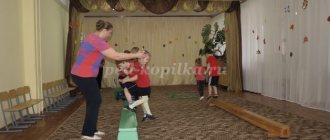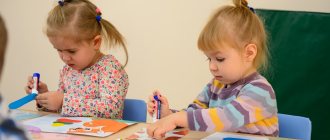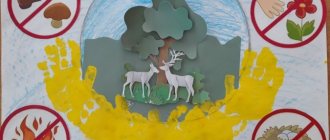Middle group. Junior preschool age. Children 4 - 5 years old
Summary of a lesson on speech development in the secondary group "Fire Safety" Summary of a lesson on speech development in the secondary group " Fire Safety "
Goal: to develop in children knowledge about the benefits and dangers of fire, compliance with the rules of careful handling of fire.
Objectives: consolidate knowledge about fire safety ; teach to talk about safety when...
Summary of a lesson on life safety in the middle group “It’s dangerous to joke with fire” Goal: To consolidate previously acquired knowledge about fire and fire . Objectives: Educational: • Clarify and deepen children’s knowledge about the benefits and dangers of fire, fire safety and rules of behavior in the event of a fire . • Develop practical skills to act in case...
Summary of a lesson on life safety in the middle group Topic: “Young firefighter”
Integration of educational areas : health, cognition, communication and fire safety in the middle group.
Goal : strengthening the psycho-emotional health of children, developing health-saving skills through compliance with fire safety rules.
Educational:
- Introduce children to the work of firefighters; teach children the rules of safe behavior in case of fire;
- To consolidate knowledge about fire safety rules and fire extinguishing equipment;
- Know the fire department telephone number and know how to use it
Educational:
- Increase personal responsibility for your actions, develop discipline and a sense of duty;
- Foster environmental behavior, develop an understanding of what actions harm nature and spoil it (forest fire).
Educational:
Develop attention, memory, speech; improve volitional qualities (dexterity, speed, endurance, strength, courage, determination) cultivate respect and interest in the work of fire department workers.
Materials and manuals for educational activities:
Poster and pictures depicting situations about fire safety, soap bubbles, cards for cutting, scissors for each child, poster for sticking, imitation fire (pictures), box with toys.
Progress of educational activities:
Educator : - Children, let's greet each other and the guests. Let's stand in a circle.
All the children gathered in a circle,
I am your friend and you are my friend.
Let's hold hands tightly,
And let's smile at each other.
Teacher : (knock on the door) - Guys, is someone knocking on our door?
— This is the postman, he brought us a parcel. Let's see who this package is from and what's in it.
Children look at the package, find toys and a letter.
Educator : - Let's read who this letter is from:
“Hello girls and boys. My name is Vova, I am a former kindergarten student, I am sending you toys that I no longer play with, I will be glad if you find them useful.”
Educator : - Now the guys will take a closer look at the toys.
- Why did Vova put matches, a candle, and sparklers among the toys? Can children play this?
Children : - No!
Educator : What should children play?
Children : - Toys.
Educator : - Probably the boy Vova does not know the safety rules, what happens when children get these dangerous objects?
Children : - Fire!
Educator : - Let the guys write an answer to the boy Vova, send him a poster where dangerous and safe objects will be depicted and so that he does not forget about them.
Raised spruce : - But, in order to send a letter, let's remember all the fire safety rules.
Physical education minute
Educator : - I will name the words, and when you hear a word related to fire safety, you should jump and clap your hands, and those that are not related, stomp your foot. (Fireman, cake, saw, fire extinguisher, package, brush, fire helmet, notes, fire, matches, 01, table, fire truck.)
- Well done, everyone did it.
Educator : - Look, guys, I have a poster on the board, let's look at what is shown there?
Children : - Fire safety rules.
Educator : -What is the first rule?
Children : - This is because children should not pick up matches.
Educator : What could happen?
Children : - Fire!
Educator: -What is the second rule?
Children : - Do not turn on or use electrical appliances.
Educator : - What will happen?
Children: - If it sparks and catches fire, there will be a fire.
Educator : - What is the third rule?
Children: - Do not use or turn on gas appliances
Educator : - A gas leak, explosion and fire may occur.
Educator : - What other rule is shown?
Children : - Call number “01”, call the fire department.
Educator : - What should you say when you dial the number “01”?
Children : - Address, last name, first name and what is on fire
Educator : - What should you not do during a fire?
Children: - Hide under the bed, in the closet so that firefighters can find it.
Educator : I see that you all remember the rules well and now you can play the game with me.
(Children stand in a semicircle.)
The game is called “This is me, this is me, these are all my friends . I will ask questions, and you must answer in unison, “This is me, this is me, these are all my friends” and clap your hands if you agree or remain silent if the proposed actions are incorrect.
- Who, sensing the smell of burning, reports a fire?
- Which of you, noticing the smoke, will shout: “Fire! We're on fire!"?
- Which of you plays tricks with fire in the morning, evening and day?
- Who, seeing smoke in the apartment, will call “04”?
- Who doesn’t light fires and doesn’t allow others to?
- Who can quietly hide matches from their little sister?
- Which one of you is playing with fire? Be honest about it!
Educator : Guess the riddle:
We must fight fire
We are bold and brave
People really need us,
Everyone's name is FIREFIGHTERS.
Educator : - And now we will play the game “Young Fireman”.
— What should a firefighter be like?
Children : - Brave, courageous, strong.
Educator : - What does a fireman need to put out a fire?
Children : -Fire extinguisher, water.
(Hand out soap bubbles to all the children.)
Educator : - At the command “FIRE - BURN”, children look for the source of fire and extinguish it (by blowing soap bubbles on the fire).
— And don’t forget to call number “01.”
“So we put out the fire, but there was a small flame left.”
“Turn around.
Turn into a light..."
Educator : - Children will stand in a small circle. Let's imagine that we are small, bright lights. Suddenly, guys, the window opened and a spring breeze flew in. And that’s all the little fire needed, it began to grow and turned into a great, angry and angry fire.
The fire is starting!
The flame is higher, the flame is steeper
Reaches right up to the clouds
The chief fireman (educator) extinguishes the fire with large soap bubbles.
Educator : -Well done guys, they coped with the task and put out the fire.
We have remembered all the fire safety rules, and now we will send a message to the boy Vova in the form of a poster about dangerous and safe objects. (Children sit at tables, cut out pictures, and paste the picture onto this poster, choosing which object is depicted as dangerous or safe.)
Educator : - Guys, we are giving this poster to the boy Vova, and in the letter we will write:
“Study and know the safety rules Vovochka and may everything be fine with you! Thank you very much for the toys! Goodbye!"
Fire safety lesson in the middle group “Dangerous objects”
Author
Litvinova Nadezhda Nikolaevna
Educator
MBDOU kindergarten k/v No. 8 “Snegovichok”
Nizhnevartovsk
Program content : Develop the ability to analyze riddles based on comparison of two objects with common external features, and draw your own conclusions. Practice using simple forms of explanatory speech. Strengthen knowledge about dangerous objects. Create conditions that encourage independent action. Cultivate a desire to help another in a difficult situation.
Material:
Telephone, pairs of pictures depicting objects with similar external features: nail - mushroom, matches - nesting dolls, kettle - saucepan, iron - refrigerator, hammer - drumsticks, scissors - glasses; puppet character - Mashenka, screen, Whatman paper, glue, silhouettes of dangerous objects, envelope with chips, delivery.
Progress of the lesson:
The phone rings, the teacher answers the phone: Hello! I'm listening to you. (Listens carefully, then hangs up.) Guys, our old friend Mashenka called. She is going to come visit us, but it seemed to me that she was very upset. What happened?
(There is a knock on the door. Mashenka appears from behind the screen and speaks in a sad voice.)
Mashenka : Hello, guys!
Educator: Hello, Mashenka! I think you're upset about something. Tell us what happened?
Mashenka: Guys, you know how much I love everything new! Yesterday my mother gave me a set of pictures with riddles. I read them, looked at them, and then accidentally dropped them, and they all got mixed up. Now I just can’t find the correct answer picture for the riddle.
Educator : Guys, can we help Mashenka?
Children: Yes!
Educator: You, Mashenka, read the riddles, and the guys will listen to them carefully and try to find the answers.
(For each riddle, two pictures are displayed, which depict objects with common external features, for example, a nail and a mushroom. Children find the desired answer picture among them and explain their choice.)
Mashenka: My Antoshka has a hat and an iron leg.
Children : Nail.
Educator : Why did you decide that? Maybe it's a mushroom, because it also has a cap and a stem?
Children: This is a nail, because the riddle says that it has an iron leg.
Mashenka: These friendly sisters spend the whole day looking for a light.
Children: These are matches.
Educator: Or maybe nesting dolls, because they are also friendly and all live together?
Children: No, nesting dolls do not make fire, only matches can light it.
Mashenka:
Knock-knock-knock-knock
There is a loud knock.
What did dad take in his hands?
What did he use to hammer the nails?
Children : Hammer.
Educator : Maybe these are drumsticks? They also knock loudly: knock-knock.
Children : Sticks knock on the drum, they don’t hammer nails.
Mashenka:
Long nose, round side.
It contains hot boiling water.
It hisses, boils,
He orders everyone to drink tea.
Children : Kettle.
Educator: Or maybe a saucepan? It's also round.
Children : She doesn’t have a spout and they don’t cook tea in a saucepan.
Mashenka: Two ends, two rings, and a carnation in the middle.
Children : Scissors.
Educator : In my opinion, these are glasses. They also have two rings and two ends (points to the arms).
Children: But there is no carnation in the middle!
Mashenka: Shiny and smooth, smoothes out wrinkles.
Children: Iron.
Educator : Or maybe a refrigerator, it’s also shiny and smooth.
Children : But the refrigerator does not smooth out wrinkles, this is done with a hot iron, and food is stored in the refrigerator.
Educator: You see, Mashenka, the guys helped you - they selected the correct answer pictures for your riddles. They depict dangerous objects. Now you and I are going to play a game called “You can - you can’t.” But first you need to find an envelope with chips, which you cannot do without in this game. Whoever finds it first will lay them out for distribution.
(Children are looking for an envelope. The child who finds it pours red and green chips into the distribution. The teacher lays out pictures depicting dangerous objects in a row.)
Educator : What are these items called?
Children: Dangerous.
Mashenka: What’s dangerous about them?
Children: If they are used incorrectly or taken without permission, an accident may occur.
Educator: In order to play the game “You can - you can’t”, each of you needs to take one red and one green chip from the distribution. Red color means that children should not use this item on their own. Green color - this item can be used, but very carefully.
After the children have taken the chips, the teacher continues: Now I will show pictures with images of dangerous objects, and you must determine whether the children can use this object or not, and pick up a chip of the desired color. Here is a picture of a teapot. What color chip should I raise?
Children: Red, because boiling water can burn you.
Similar questions are asked for each picture.
After the game is over, Mashenka says: You guys are great, you helped me so much today! But I haven’t yet remembered which of these items children are prohibited from using, and which they can, but very carefully.
Educator: Don’t be upset, Mashenka. So that you remember everything well, the guys can make a poster “Caution, dangerous objects!” Really, guys? And you will hang it on your wall at home and study it.
Educator : Guys, on the tables there are already cut out silhouettes of dangerous objects. Glue them onto a large piece of paper and you have a poster. (Children complete the task).
Educator: How many of them did you get?
Children : Six.
Educator: But these are not all the dangerous objects that are in every home. We'll talk about the rest next time. Mashenka, we give this poster to you! Study it and may everything be fine for you!
Mashenka: Thank you very much, guys! Goodbye!
“Certificate of Publication” Series A No. 0000705 sent on September 19, 2012. receipt No. 62502652822417
We invite teachers of preschool education in the Tyumen region, Yamal-Nenets Autonomous Okrug and Khanty-Mansi Autonomous Okrug-Yugra to publish their teaching materials: - Pedagogical experience, original programs, teaching aids, presentations for classes, electronic games; — Personally developed notes and scenarios of educational activities, projects, master classes (including videos), forms of work with families and teachers.
Why is it profitable to publish with us?
1. “Kindergartens of the Tyumen Region” is an officially registered specialized media outlet at the federal level. 2. The activities of the editorial office are supported by the Department of Education and Science of the Tyumen Region 3. We issue a “Certificate of Publication” in the media. 4. The document has a unique number, is entered in the register, has the original seal of the editorial office of the online publication and signature. 5. “Certificate of publication” in the media is sent to the author in both paper and electronic versions.
Details >>>
Sample “Certificate of publication of author’s methodological material in the media.”pdf
Share








